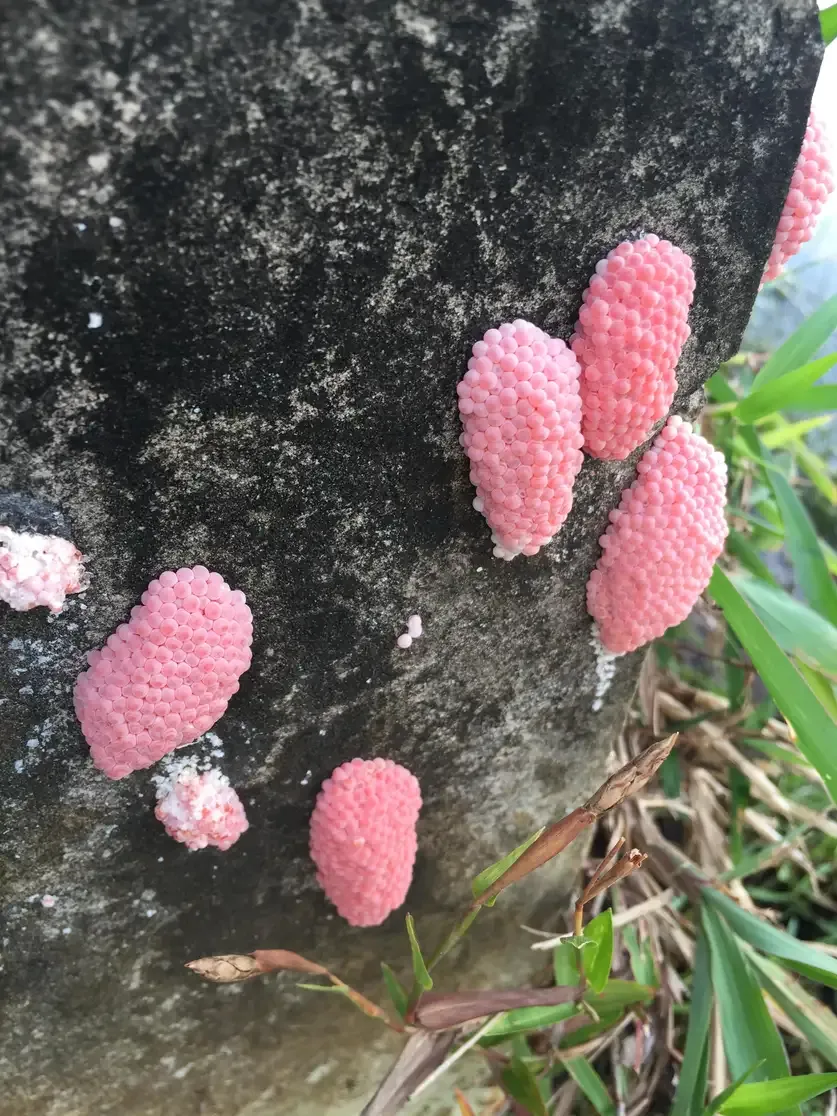If you’ve ever stumbled upon clusters of tiny, bubblegum-pink eggs in your garden, you might think they look charming or even harmless. But beware—these vibrant eggs are laid by the invasive apple snail, a formidable threat to ecosystems everywhere. Native to South America, apple snails have spread across the globe, causing devastation to crops, plants, and natural habitats alike.
The Apple Snail: A Freshwater Giant
Towering over most garden snails, the apple snail is a freshwater mollusk known for its impressive size. Their shells can grow up to ten centimeters wide, making them an unmistakable presence. Preferring wet environments such as swamps, ponds, and lakes, apple snails thrive particularly well in warm regions, where their populations can explode almost uncontrollably.
These snails produce masses of pink or orange eggs, each about 2–3 millimeters in size. A single egg cluster can contain between 400 to 600 eggs, highlighting just how quickly these invaders can multiply.
Why Apple Snails Are So Dangerously Invasive
Classified among the world’s 100 most invasive exotic species, apple snails are biological powerhouses. Their adaptability, rapid breeding, and resilience have been amplified by global warming, allowing them to colonize new territories far beyond their native range.
Originally confined to South America’s warm, wetlands, these snails have now made themselves at home in North America, Europe, and Asia. Once introduced, apple snails don't just survive—they dominate.
They are relentless consumers of plant material, and in places like Southeast Asia, they have caused catastrophic damage to rice fields since their introduction in the 1980s. With their fast reproduction and voracious appetites, they often outcompete native species, leading to biodiversity collapse.
Spotting Apple Snail Eggs: A Critical First Step
One of the clearest signs of an apple snail infestation is the presence of their neon-pink egg clusters. Typically attached to leaves, branches, or any surface near water, these eggs are designed to be highly visible.
Their coloration serves as a warning to predators: the eggs are laced with toxins, making them unappetizing and dangerous to consume.
Early intervention is crucial. Each egg mass can spawn hundreds of new snails, and once they hatch, the damage escalates quickly. In affected regions, authorities urge the public to report sightings immediately to help contain outbreaks.
How Far Have Apple Snails Spread, and How Much Damage Have They Caused?
The apple snail’s global journey is astonishing. In the United States, they have established themselves in states like Florida, Texas, and California.
Across Asia, they're notorious for ravaging rice paddies, while in Europe, countries such as Spain and France have sounded alarms.
In 2018, a sighting of apple snail eggs near Fréjus, France, triggered swift, though not wholly successful, containment efforts. Their destructive habits are particularly alarming.
By devouring aquatic plants, they dismantle ecosystems, reduce oxygen levels in water, and create cascading effects that impact fish, amphibians, and even water quality itself. In agricultural areas, their appetite for young crops leads to devastating financial losses for farmers.
Fighting Back Against the Apple Snail Invasion
Controlling apple snails is a tough challenge. Their rapid reproduction and hardy nature mean that even small populations can rebound quickly. Many areas have banned their sale as pets, cutting off one avenue for their spread, but more proactive measures are needed.
Some effective strategies include:
- Reporting Sightings: Hotlines and websites allow citizens to alert authorities quickly.
- Manual Egg Removal: Scraping off and safely disposing of egg masses can prevent future generations—gloves are a must due to toxins.
- Biological Control: Researchers are investigating natural predators or parasites, though this must be done cautiously to avoid unintended consequences.
- Public Education: Awareness campaigns help communities recognize and respond to the threat early.
Why Gardeners Should Stay Alert
If you cherish your garden, apple snails should be on your radar. Especially if you have ponds or other water features, these snails can decimate your plant life in no time. Their pink eggs are more than just unsightly—they are a harbinger of ecological disaster. In ecosystems where apple snails thrive, native plants are often wiped out, setting off a chain reaction that affects pollinators, fish, and birds.
By removing and reporting egg sightings, gardeners can help protect not just their own green spaces but the larger environment as well. Spotting those bubblegum-pink eggs might be unsettling, but recognizing their danger is the first step toward action. Apple snails represent a serious global threat to biodiversity, agriculture, and natural ecosystems.
By staying alert, reporting infestations, and spreading awareness, we can all contribute to slowing the spread of these invasive pests. Protecting our gardens and ecosystems starts with understanding—and acting upon—the warning signs, one bright pink egg cluster at a time.


.webp)

